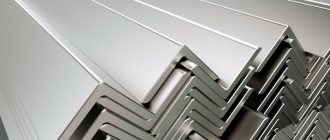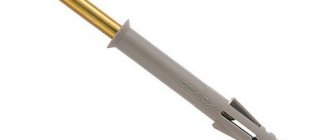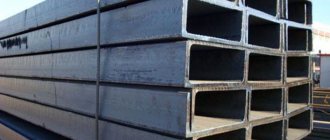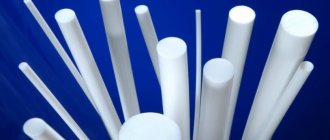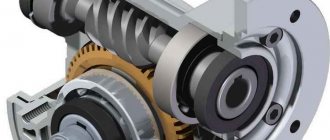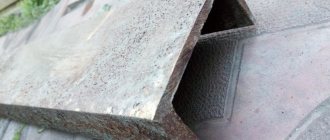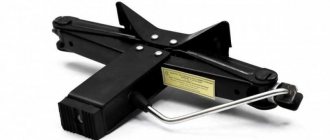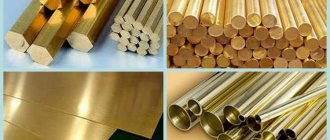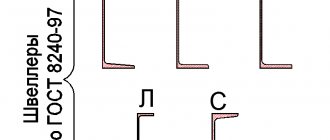The parameters of one of the most popular types of rolled metal - steel equal-flange angle - are determined by GOST 8509-93. The use of GOST in the production of such products not only unifies their types, but also improves the interaction between producers and consumers. The dimensions and weight of equal-flange steel angles, which are manufactured in full compliance with the regulatory document, make it possible to use these characteristics to accurately calculate material consumption, which is very important when carrying out construction and repair work.
How a corner is made - differences in products
Many uses have been invented for the standard L-shaped profile of a steel corner, which is understandable - the bending point is at the same time a stiffening rib and a convenient shape for laying corners on other surfaces. A popular type of rolled product is made mainly from ordinary carbon steel, less often from high-quality structural steel. Over the years, the production of steel angles has acquired many GOSTs, for example, general requirements and characteristics for the product are present in GOST 19771-93, while each type and method of rolling has its own separate GOST.
Hot rolled angle is produced by rolling a bloom (an ingot of metal) through a series of rotating shafts that apply the required pressure to the hot metal. During the movement, an L-shape without a radius on the outside is also formed. There is a radius on the inside - it plays the important role of an additional stiffener. According to GOST 8509-93, maximum deviations from the length of angles on sale should be no more than 0.75% of those declared by the manufacturer, and the curvature coefficient should be no more than 0.4% of the length.
The technology of cold-rolled production is significantly different - basically, angles are made from metal strips (ordinary steel) on roll forming machines, or strip blanks are rolled through a series of shafts. Due to their higher cost, such products are not suitable for creating load-bearing and monolithic structures; their scope of application is limited mainly to finishing work. The range is represented by products from 6 to 12 meters. Externally, it is very simple to distinguish cold-rolled products from hot-rolled ones - the former do not have the scale characteristic of the latter.
Varieties of equal-flange steel angles
Equal angle corners are divided into several categories depending on the manufacturing method and the raw materials used for their production. All geometric parameters, as well as permissible deviations for them, are regulated by two regulatory documents:
- GOST 8509-93 (production of hot-rolled equal-flange angles);
- GOST 19771-93 (production of equal-flange steel angles obtained by bending).
You can familiarize yourself with the GOST requirements and the range of hot-rolled and bent equal-flange steel angles by downloading the relevant documents in pdf format from the links below.
The difference between equal-shelf and unequal-shelf products is that the former have shelves of the same dimensions (width), while the latter have different shelves. Hot-rolled corner profiles are manufactured using the following technology: a hot billet is rolled between the shafts of a special rolling mill, where, under pressure, it is formed into a product with the required geometric shape and dimensions.
In order to produce a metal corner of the bent type, rolled sheets of the appropriate size are bent on roll forming equipment or on pipe mills. Due to the peculiarities of their production, hot-rolled profiles are characterized by higher strength, but bent corners also have their advantages: high dimensional accuracy, light weight, wide range.
The range of equal angle angles includes products from:
- high strength steel;
- alloyed, high-alloy steel;
- alloys characterized by increased heat resistance, heat resistance and corrosion resistance.
The most common material for the production of bent angles is also carbon steel, the characteristics of which must comply with GOST 380-94.
Advantages and disadvantages of hot-rolled angles
Hot rolled steel has a number of advantages, which include:
- scope of application – including at large enterprises for bulk and regular orders;
- Sizes are not limited;
- performance characteristic - maximum speed;
- Products with thick walls can be processed.
In addition to the advantages, hot rolled steel also has several disadvantages. Firstly, the high cost of equipment. Secondly, installing such equipment will require a large amount of free space.
Application
Due to the manufacturability of its shape, good weldability, strength and resistance to various types of loads, steel angles are used almost everywhere. You can buy a steel corner corner either at metal wholesale depots in your city or on the Internet. It is used primarily in construction as one of the main elements of load-bearing, heavily loaded metal structures - floors, spans, trusses, etc.
The corner profile shape is ideal for making door and window openings. An unequal angle, which has a different moment of resistance with respect to different axes, is well suited for the manufacture of curved structures, such as arches.
Small standard sizes are used in the manufacture of furniture to strengthen its frame. Stainless steel profiles are used for interior decoration.
The corner is widely used in mechanical engineering - in the production of cars, carriages, large-sized and special equipment.
During electrical installation work, the corner profile is used as a basis for fastening equipment and cables. An angle made of low-alloy steel is used for high loads and the need to protect structures from aggressive environments and high humidity.
Characteristics of an unequal angle
The scope of application is no less wide. Moreover, metal corners are often used as a decorative addition.
The main purpose is to use it to strengthen various structures. As well as use in the production of military equipment. Furniture metal corners are quite popular.
- Instructions on how to choose an I-beam: characteristics, dimensions, calculation of parameters and loads on the beam
- We choose VGP pipes wisely: standard sizes, selection tips and characteristics of water and gas pipes
- How to select and calculate a channel - rules of use, size tables, calculation of loads and selection of profile weight
I would like to name the small mass as the main advantage.
Steel angle - strictly according to GOST
Based on the cross-sectional type, products are divided into equal-flange and unequal-flange. The shelf of an angle is one of its sides, to put it in plain language. Equal-sex ones, as the name suggests, have identical shelves, which cannot be said about unequal-sex ones. The range of the latter is limited and is often made to order.
The shelf width varies from 20 mm to 200 mm, the metal thickness reaches a maximum of 16 mm. The weight of a steel angle is measured in kilograms per meter, for example, for an equal-flange product with a shelf width of 20 mm and a metal thickness of 3 mm, the weight will be 0.890 kg/m. For the largest representative of this family - a two-hundred-millimeter product - with a thickness of 12 mm, the weight will be about 37 kg/m.
According to the accuracy class, corners are divided into high-precision products, also known as class A, and ordinary accuracy, class B. Products are numbered depending on the width of the shelf, which is measured in millimeters. The standard length of products is from six to twelve meters, this is not counting the unmeasured length, the minimum value of which is 4 meters. When producing large batches of a strictly defined size, according to GOST, 15% of oversized products are allowed.
GOST standards specifying the assortment of equal angle angles
In addition to such parameters as the manufacturing method and the geometric dimensions of the corner, specified by the product range, the mentioned products are usually divided according to the use case (this sets the requirements for the materials from which the corner is made).
The main materials for the production of this type of long products are steel:
- Ordinary quality carbon, produced according to standard 380-2005 (GOST);
- Low alloy, high strength (standard 19281-89).
For each of these types, its own standard has been developed that specifies the specifications for its production. Based on this parameter, our customers have the following available for purchase:
- Equal-flange steel angle, intended for installation of steel building structures, complying with the interstate standard of the EAEU 27772-2015 (GOST);
- Angles manufactured according to standard 19281-2014 (GOST), made of low-alloy or high-quality non-alloy steels
Manufacturing in accordance with the provisions of the standards:
- 535-2005 (GOST). Refers to products of special and general use. Manufactured from carbon steel alloys of so-called “general” quality;
- 5521-93 (GOST as amended on April 16, 2003). They are in demand, first of all, by the shipbuilding industries (alloys of increased and normal strength). A corner manufactured in accordance with standard 52927-2015 (GOST R) has a similar purpose;
- 6713-91. An angle manufactured in accordance with this standard is used in bridge construction (low-alloy structural alloys are used in its manufacture). A corner made in accordance with standard 55374-2012 (GOST R) has a similar purpose.
Equal angle corner GOST 8509-93
This rental has the following technical parameters
| Options | Minimum value | Maximum value |
| Shelf width, mm | 20 | 250 |
| Shelf thickness, mm | 3.0 | 35 |
| Weight of 1 linear m, kg | 0.88 | 128 |
| Cross-sectional area, cm2 | 1.12 | 163 |
The maximum permissible deviations in the width of the shelf should be no more than:
- 1 mm for shelves up to 50 mm;
- 5 mm for shelves up to 100 mm;
- 2 mm for shelves up to 150 mm;
- 3 mm for shelves up to 200 mm.
Rolling accuracy can be of two types: A (high) or B (normal).
The length of the product, according to GOST, can be from 4 to 12 meters. In this regard, there are several types of length:
- Measured;
- Measured with unmeasured lengths (up to 5% of the total weight in the batch);
- Multiple dimensional;
- Multiple measured with unmeasured lengths (up to 5% of the total weight in the batch);
- Unmeasured.
- Limited within unlimited limits.
If necessary and in agreement with the manufacturer, the minimum length of the corner can be from 3 m, and the maximum - more than 12 m.
Angle angle GOST 8510-86
This standard clearly establishes the parameters of the mass of rolled products, as well as its dimensions:
| Options | Min | Max |
| Pen width, mm | 25 | 200 |
| Butt width, mm | 16 | 125 |
| Shelf thickness, mm | 3.0 | 16 |
| Weight 1 m, kg | 0.91 | 39.07 |
| Cross-sectional area, cm2 | 1.16 | 49.77 |
The maximum permissible deviations in the width of the shelves (feather/pad) and their thickness should be no more than:
- 0/0.3 mm for shelves up to 50/32 mm;
- 5/0.4 mm for shelves up to 90/56 mm;
- 0/0.4 mm for shelves up to 160/100 mm;
- 0/0.5 mm for shelves up to 200/150 mm.
Rolling accuracy can be of two types: A (high) or B (normal).
The length of the corner according to the guest can be from 4 to 12 meters. In this regard, there are several types of length:
- Measured;
- Measured with unmeasured lengths (up to 5% of the total weight in the batch);
- Multiple dimensional;
- Multiple measured with unmeasured lengths (up to 5% of the total weight in the batch);
- Unmeasured.
- Limited within unlimited limits.
If necessary and in agreement with the manufacturer, the maximum length of the product can be more than 12 m.
Such rolled products are made from hot- and cold-rolled steel on special roll forming mills. They can also have shelves of the same or different sizes (feather and butt), so they have their own standards.
For production we use carbon steel grades of regular and high quality with a tensile strength of up to 47 kgf/mm2 and over 47 kgf/mm2
Equal flange bent corner GOST 19771-93
In terms of size and weight, bent equal-flange angles can have the following values:
| Options | Made of steel with tensile strength up to 47 kgf/mm2 | Made of steel with a tensile strength of more than 47 kgf/mm2 | ||
| Min | Max | Min | Max | |
| Shelf width, mm | 36 | 120 | 55 | 160 |
| Shelf thickness, mm | 3.0 | 6.0 | 3.0 | 4.0 |
| Weight of 1 linear m, kg | 1.57 | 10.78 | 2.43 | 11.10 |
| Cross-sectional area, cm2 | 2.0 | 13.78 | 3.10 | 12.43 |
Bent equal angles differ in profiling accuracy into three categories:
- A. High accuracy;
- B. increased.
- B. Regular.
The length of the product, according to GOST, can be from 3 to 12 meters. In this regard, there are several types of length:
- Measured;
- Measured from unmeasured (up to 7% of the total mass in the batch);
- Multiple dimensional;
- Multiple measured with unmeasured (up to 7% of the total mass in the batch);
- Unmeasured.
The error in the width of the shelves should not exceed 0.75 mm 1.5 mm for high-precision corners and from 1.5 to 3.0 mm for products of normal precision.
How to choose steel angles?
So, how should you choose the right metal corners?
The first is accuracy. You can recognize it by the letter in the marking. If there is a letter A, then this means that the corner has high accuracy. If Latin B is indicated, this means that this product has normal accuracy.
What can this parameter actually affect? It shows the parameters of the finished product (evenness, accuracy, thickness, as well as any deviations).
For small rolled metal products, high accuracy is an important characteristic. But for large products, completely different characteristics are important.
The second is the manufacturing methods. There are two types of manufacturing - cold rolling and hot rolling. That is, during hot production, products are rolled in special forms through hot machines (or the finished product is bent).
If we compare a cold-rolled product with a hot-rolled one, the former have low strength. Therefore, if high strength is required, then this steel angle will not work; it is better not to purchase it.
The third thing to pay attention to is the shelves. There are two types - equilateral and non-equilateral. Option No1 is a metal strip that has an angle of 90% in the middle. The second No2 resembles the letter G because one side is longer than the other.
Corners that have equal sides are stronger, so they are used more often. But if it is necessary to individually calculate the length of both shelves, then non-equilateral corners are used here. This option also has high reinforcing properties.
And fourth is the steel from which the corners are made. In the manufacture of metal corners, more than one type of steel is used. If ordinary steel was used in the manufacture of the corner, then its price will be lower.
If in construction it is necessary for the structure to be reliable, so that it is not affected by the environment and temperature changes, then you should opt for products made of low-alloy steel.
Characteristics of isosceles angles
High-precision steel, alloy metal or stable, heat-resistant compounds are used as raw materials for production.
The advantage is the affordable price, as well as the versatility of quality and wide scope of application. Moreover, such products are resistant to corrosion processes, do not deform, are not exposed to temperature and are well welded.
- Welding of metal structures
- Features of cold rolled sheets - production technology, features, dimensions, properties and markings
- Technical features of hot-rolled sheet - classification, manufacturing method, application options and processing features
Metal corners can be used for fastening, in mechanical engineering, installation of metal structures, for monolithic structures, in agriculture.
Equal corners are an excellent option for stairs.
The corner can be made from non-ferrous metals, for example, aluminum or magnesium products. Moreover, the corners made of non-ferrous metal will be pressed or bent.
Types of metal corners
Hot rolled. It is made from a finished steel billet, which is heated and passed through a machine. And according to the dimensions that are given, the product is formed.
Bent. This type is made from a strip of steel; it can be used either cold or hot rolling, during which a bend is formed. This corner will suit any design idea.
Equal. The name speaks for itself. All sides of this angle are equal.
Unequal. This corner has different side sizes.
The metal corner has standard dimensions:
- 20x20 mm;
- 25x25mm;
- 50x50mm;
- 70x70mm;
- 75x75mm;
- 100x100mm;
- 120x120mm;
- 150x150mm;
- 200x200mm.
You can also classify metal corners by length. There are two types. This:
- Measured;
- Unmeasured.
The lengths of measuring metal corners are 6,7,9,10,11 and 12 mm. The price of this product varies not by unit, but by weight category. That is, the buyer will pay not for the quantity of products, but for its weight.
Unmeasured metal corners can have different lengths. Typically it varies from 4 to 12 mm.
Application areas of metal corners
- In homestead construction. Angular steel is used for the construction of large-sized greenhouses and small greenhouses, fences with chain-link mesh, portable and stationary gazebos.
- When constructing stairs - internal and external. The corner can be used for the manufacture of such metal products as step frames, porch platform frames, porch supports, stair railings.
- For strengthening window and door openings in brick or block masonry. The use of steel corner bars prevents the appearance of cracks in the wall and thereby extends the service life of the entire building.
- Production of canopies, street structures (benches, tables, swings), frames for bars on doors and windows, wickets, gates.
- Manufacturing of shelving in warehouses and in production , cabinet frames, trolleys, workbenches, various production equipment - testing and assembly stands.
- In everyday life - frames of metal doors, household brick stoves.
The widespread use of metal angles in construction provides the following advantages of rolled steel: a combination of strength and low weight, ease of transportation, storage and installation, durability subject to anti-corrosion treatment.
Size tables. Weight 1 meter
Table 1. Equal flange hot-rolled angle GOST 8509-93 .
| Corner number | mm | Cross-sectional area cm2 | Reference values for axes | Macca 1m corner, kg | ||||||||||||||
| b | t | R | r | x - x | x0-x0 | U0-U0 | Jxy, cm4 | Y0, cm | ||||||||||
| Jx, cm4 | Ix, cm3 | ix, cm | Jy0min, cm4 | ix0max, cm | Jy0min, cm | Wy0, cm3 | iy0min, cm | |||||||||||
| 2 | 20 | 3 4 | 3,5 | 1,2 | 1,13 1,46 | 0,40 0,50 | 0,28 0,37 | 0,59 0,58 | 0.6З 0.78 | 0,75 0,73 | 0,17 0,22 | 0,20 0,24 | 0,39 0,38 | 0,23 0,28 | 0,60 0,64 | 0,89 1,15 | ||
| 2,5 | 25 | 3 4 5* | 1,43 1,86 2,27 | 0,81 1,03 1,22 | 0,46 0,59 0,71 | 0,75 0,71 0,73 | 1,29 1,62 1,91 | 0,95 0,93 0,92 | 0,34 0,44 0,53 | 0,33 0,41 0,47 | 0,49 0,48 0,48 | 0,47 0,59 0,69 | 0,73 0,76 0,80 | 1,27 1,46 1,78 | ||||
| 2,8 | 28 | 3 | 4,0 | 1,3 | 1,62 | 1,16 | 0,58 | 0,85 | 1,84 | 1,07 | 0,48 | 0,42 | 0,55 | 0,68 | 0,80 | 1,27 | ||
| 3 | 30 | 3 4 5* | 4,0 | 1,3 | 1,74 2,27 2,78 | 1,45 1,84 2,20 | 0,67 0,87 1,06 | 0,91 0,80 0,89 | 2,30 2,92 3,47 | 1.15 1.1З 1.12 | 0,60 0,77 0,94 | 0,53 0,61 0,71 | 0,59 0,58 0,58 | 0,85 1,08 1,27 | 0,85 0,89 0,93 | 1,36 1,78 2,18 | ||
| 3,2 | 32 | 3 | 4,5 | 1,5 | 1,36 2,43 | 1,77 2,26 | 0,77 1,0 | 0,97 0,96 | 2,80 3,58 | 1,23 1,21 | 0,74 0,94 | 0,59 0,71 | 0,63 0,62 | 1,03 1,32 | 0,89 0,94 | 1,46 1,91 | ||
| 4 | ||||||||||||||||||
| 3,5 | 35 | 3 | 2,04 2,17 3,28 | 2,35 3,01 3,61 | 0,93 1,21 1,47 | 1,07 1,06 1,05 | 3,72 4,76 5,71 | 1,35 1,33 1,32 | 0,97 1,25 1.52 | 0,71 0,88 1,02 | 0,69 0,68 0,68 | 1,37 1,75 2,10 | 0,97 1,01 1,05 | 1.60 2,10 2,58 | ||||
| 4 | ||||||||||||||||||
| 5 | ||||||||||||||||||
| 4 | 40 | 3 4 5 b* | 5,0 | 1,7 | 2,35 3,08 3,79 4,48 | 3,55 4,58 5.53 6,41 | 1,22 1,60 1,95 2,30 | 1.23 1,22 1,21 1,20 | 5,63 7,26 8,75 10,13 | 1,55 1,53 1,52 1.50 | 1,47 1,90 2,30 2,70 | 0,95 1,19 1,39 1,58 | 0,79 0,78 0,78 0,78 | 2,08 2,68 3,22 3,72 | 1,09 1,13 1,17 1,21 | 1,85 2,42 2,98 3,52 | ||
| 4,5 | 45 | 3 4 5 6* | 2,65 3,48 4,29 5,08 | 5,13 6,63 8,03 9,35 | 1,56 2,04 2,51 2,95 | 1,39 1,38 1,37 1,36 | 8,13 10,52 12,74 14,80 | 1,75 1,74 1,72 1,71 | 2,12 2,74 3,33 3,90 | 1,24 1,54 1,81 2.06 | 0,89 0,89 0,88 0,88 | 3,00 3,89 4,71 5,45 | 1,21 1,26 1,30 1,34 | 2,08 2,73 3,37 3,99 | ||||
| 5 | 50 | 3 4 5 6 7* 8* | 5,5 | 1,8 | 2,96 3,89 4,80 5,69 6,56 7,41 | 7,11 9,21 11,20 13,07 14.84 16,51 | 1,94 2,54 3,13 3,69 4,23 4,76 | 1,55 1,54 1,53 1,52 1,50 1,49 | 11,27 14,63 17,77 20,72 23.47 26,03 | 1,95 1,94 1,92 1,91 1,89 1,87 | 2,95 3,80 4,63 5,43 6,21 6,98 | 1,57 1,95 2,30 2,63 2,93 3,22 | 1,00 0,99 0,98 0,98 0.97 0,97 | 4,16 5,42 6,57 7,65 8,63 9,52 | 1,33 1,38 1,42 1,46 1,50 1,53 | 2,32 3,05 3,77 4,47 5,15 5,82 | ||
| 5,6 | 56 | 4 5 | 6,0 | 2,0 | 4,38 5,41 | 13,10 15,97 | 3,21 3,96 | 1,73 1,72 | 20.79 25,36 | 2,18 2,16 | 5,41 6,59 | 2,52 2,97 | 1,11 1,10 | 7,69 9,41 | 1,52 3,57 | 3,44 4,25 | ||
| 6* | 60 | 4 | 7,0 | 2,3 | 4,72 | 16,21 | 3,70 | 1,85 | 25,69 | 2,33 | 6,72 | 2,93 | 1,19 | 9.4S | 1,62 | 3,71 | ||
| 5 | 5,83 | 19,79 | 4,56 | 1,84 | 31,40 | 2,32 | 8,18 | 3,49 | 1,18 | 11,61 | 1,66 | 4,58 | ||||||
| 6 | 6,92 | 23,21 | 5,40 | 1,83 | 36,81 | 2,31 | 9,60 | 3,99 | 1,18 | 13,60 | 1,70 | 5,43 | ||||||
| 8 | 9,04 | 29,55 | 7,00 | 1,81 | 46,77 | 2,27 | 12,34 | 4,90 | 1,17 | 17,22 | 1,78 | 7,10 | ||||||
| 10 | 11,08 | 35,32 | 8,52 | 1,79 | 55,64 | 2,24 | 15,00 | 5,70 | 1,16 | 20,32 | 1,85 | 8,70 | ||||||
| 6,3 | 63 | 4 | 4,96 | 18,86 | 4,09 | 1,95 | 29,90 | 2,45 | 7,81 | 3,26 | 1,25 | 11,00 | 1,69 | 3,90 | ||||
| 5 | 6,13 | 23,10 | 5,05 | 1,94 | 36.8O | 2,44 | 9,52 | 3,87 | 1,25 | 13,70 | 1,74 | 4,81 | ||||||
| 6 | 7,28 | 27,06 | 5,98 | 1,93 | 42,91 | 2,43 | 11,18 | 4,44 | 1,24 | 15,90 | 1,78 | 5,72 | ||||||
| 7 | 70 | 4,5 | 8,0 | 2,7 | 6,20 | 29,04 | 5,67 | 2,16 | 46,03 | 2,72 | 12,04 | 4,53 | 1,39 | 17,00 | 1.8S | 4,87 | ||
| 5 | 6,86 | 31,94 | 6,27 | 2,16 | 50,67 | 2,72 | 13,22 | 4,92 | 1,39 | 18,70 | 1,90 | 5,38 | ||||||
| 6 | 8,15 | 37,58 | 7,43 | 2,15 | 59,64 | 2,71 | 15,52 | 5,66 | 1,38 | 22,10 | 1,94 | 6,39 | ||||||
| 7 | 9,42 | 42.98 | 8,57 | 2.14 | 68,19 | 2,69 | 17,77 | 6,31 | 1,37 | 25,20 | 1,99 | 7,39 | ||||||
| 8 | 10,67 | 48,16 | 9,68 | 2,12 | 76,35 | 2,68 | 19,97 | 6,99 | 1,37 | 28,20 | 2,02 | 8,37 | ||||||
| 10* | 13,11 | 57,90 | 11,82 | 2,10 | 91,52 | 2,64 | 24,27 | 8,17 | 1,36 | 33,60 | 2,10 | 10,29 | ||||||
| 7,5 | 75 | 5 | 9,0 | 3,0 | 7,39 | 39,53 | 7,21 | 2,31 | 62,65 | 2,91 | 16,41 | 5,74 | 1,49 | 23,10 | 2,02 | 5,80 | ||
| 6 | 8,78 | 46,57 | 8,57 | 2,30 | 73,87 | 2,90 | 19,28 | 6,62 | 1,48 | 27,30 | 2,06 | 6,89 | ||||||
| 7 | 10,15 | 53,34 | 9,89 | 2,29 | 84,61 | 2,89 | 22,07 | 7,43 | 1,47 | 31,20 | 2,10 | 7,96 | ||||||
| S | 11,50 | 59,84 | 11,18 | 2,28 | 94,89 | 2,87 | 24,80 | 8,16 | 1,47 | 35,00 | 2,15 | 9,02 | ||||||
| 9 | 12,83 | 66,10 | 12,43 | 2,27 | 104,72 | 2,86 | 27,48 | 8,91 | 1,46 | 38,60 | 2,18 | 10,07 | ||||||
| 8 | 80 | 5,5 | 9,0 | 3,0 | 8,63 | 52,68 | 9,03 | 2,47 | 83,56 | 3,11 | 21,80 | 7,10 | 1,59 | 30,90 | 2,17 | 6,78 | ||
| 6 | 9,38 | 56,97 | 9,ao | 2,47 | .90,40 | 3,11 | 23,54 | 7,60 | 1,58 | 33,40 | 2,19 | 7,36 | ||||||
| 7 | 10,85 | 65,31 | 11,32 | 2,45 | 103,60 | 3,09 | 26,97 | 8,55 | 1,58 | 38,30 | 2,23 | 8,51 | ||||||
| & | 12,30 | 73,36 | 12,80 | 2,44 | 116,39 | 3,08 | 30,32 | 9,44 | 1,57 | 43,00 | 2,27 | 9,65 | ||||||
| 10* | 15,14 | 83,58 | 15,67 | 2,42 | 140,31 | 3,04 | 36,85 | 11,09 | 1,56 | 56,70 | 2,35 | 11,88 | ||||||
| 12* | 17,90 | 102,74 | 18,42 | 2,40 | 162,27 | 3,01 | 43,21 | 12,62 | 1,55 | 59,50 | 2,42 | 14,05 | ||||||
| 9 | 90 | 6 | 10,0 | 3,3 | 10,61 | 82,10 | 12,49 | 2,78 | 130,00 | 3,50 | 33,97 | 9,88 | 1,79 | 48,10 | 2,43 | 8,33 | ||
| 7 | 12,28 | 94,30 | 14,45 | 2,77 | 149,67 | 3,49 | 38,94 | 11,15 | 1,78 | 55,40 | 2,47 | 9,64 | ||||||
| 8 | 13,93 | 106,11 | 16,36 | 2,76 | 168,42 | 3,48 | 43,80 | 12,34 | 1,77 | 62,30 | 2,51 | 10,93 | ||||||
| 9 | 15,60 | 118,00 | 18,29 | 2,75 | 186,00 | 3,46 | 48,60 | 13,48 | 1,77 | 68,00 | 2,55 | 12,20 | ||||||
| 10* | 17,17 | 128,66 | 20,07 | 2,74 | 203,93 | 3,45 | 53,27 | 14,54 | 1,76 | 75,30 | 2,59 | 13,48 | ||||||
| 12* | 20,33 | 149,67 | 23,85 | 2,71 | 235,88 | 3,41 | 62,40 | 16,53 | 1,75 | 86,20 | 2,67 | 15,96 | ||||||
| 10 | 100 | 6 | 12,0 | 4,0 | 12,82 | 122,10 | 16,69 | 3,09 | 193,46 | 3,89 | 50,73 | 13,38 | 1,99 | 71,40 | 2,68 | 10,06 | ||
| 7 | 13,75 | 130,59 | 17,90 | 3,08 | 207,01 | 3,88 | 54,16 | 14,13 | 1,98 | 76,40 | 2,71 | 10,79 | ||||||
| 8 | 15,60 | 147,19 | 20,30 | 3,07 | 233,46 | 3,87 | 60,92 | 15,66 | 1,98 | 86,30 | 2,75 | 12,25 | ||||||
| 10 | 19,24 | 178,95 | 24,97 | 3,05 | 283,83 | 3,84 | 74,08 | 18,51 | 1,96 | 110,00 | 2,83 | 15,10 | ||||||
| 12 | 22,80 | 208,90, | 29,47 | 3,03 | 330,95 | 3,81 | 86,84 | 21,10 | 1,95 | 122,00 | 2,91 | 17,90 | ||||||
| 14 | 26,28 | 237,15 | 33,83 | 3,00 | 374,98 | 3,78 | 99,32 | 23,49 | 1,94 | 138,00 | 2,99 | 20,63 | ||||||
| 15* | 27.99 | 250,68 | 35,95 | 2,99 | 395,87 | 3,76 | 105,48 | 24,62 | 1,94 | 145,00 | 3,03 | 21,37 | ||||||
| 16 | 29,68 | 263,82 | 38,04 | 2,98 | 416,04 | 3,74 | 111,61 | 25,79 | 1,94 | 152,00 | 3,06 | 23,30 | ||||||
| 11 | 110 | 7 | 15,15 | 175,61 | 21,83 | 3,40 | 278,54 | 4,29 | 72,68 | 17,36 | 2,19 | 106,00, | 2,96 | 11,89 | ||||
| 8 | 17,20 | 198D7 | 24,77 | 3,39 | 314,51 | 4,28 | 81,83 | 19,29 | 2,18 | 116,00 | 3,00 | 13,50 | ||||||
| 12 | 120 | 8 | 12,0 | 4,0 | 18,80 | 259,75 | 29,68 | 3,72 | 412,45 | 4,68 | 107,04 | 23,29 | 2,39 | 153,00 | 3,25 | 14,76 | ||
| 10 | 23,24 | 317,16 | 36,59 | 3,69 | 503,79 | 4,66 | 130,54 | 27,72 | 2,37 | 187,00 | 3,33 | 18,24 | ||||||
| 12 | 27,60 | 371,80 | 43,30 | 3,67 | 590,28 | 4,62 | 153,33 | 31,79 | 2,36 | 218,00 | 3;41 | 21,67 | ||||||
| 15 | 33,99 | 448,90 | 52,96 | 3,63 | 711,32 | 4,57 | 186,48 | 37,35 | 2,34 | 262,00 | 3,53 | 26.68 | ||||||
| 12,5 | 125 | 8 | 14,0 | 4,6 | 19,69 | 294,36 | for, 20 | 3,87 | 466,76 | 4,87 | 121,98 | 25,67 | 2,49 | 172,00 | 3,36 | 15,46 | ||
| 9 | 22,0 | 327,48 | 36,00 | 3,86 | 520,00 | 4,86 | 135,58 | 28,26 | 2,48 | 192,00 | 3,40 | 17,30 | ||||||
| 10 | 24,33 | 359,82 | 39,74 | 3,85 | 571,04 | 4,84 | 148,59 | 30,45 | 2,47 | 211,00 | 3,45 | 19,10 | ||||||
| 12 | 2M9 | 422,23 | 47,06 | 3,82 | 670,02 | 4,82 | 174,43 | 34,94 | 2,46 | 248,00 | 3,53 | 22,68 | ||||||
| 14 | 33>37 | 481,76 | 54,17 | 3,80 | 76190 | 4,78 | 199,62 | 39,10 | 2,45 | 232,00 | 3,61 | 26,20 | ||||||
| 16 | 37,77 | 538,56 | 61,09 | 3,78 | 852,84 | 4,75 | 224,29 | 43,10 | 2,44 | 315,00 | 3,68 | 29,65 | ||||||
| 14 | 140 | 9 | 14,0 | 4,6 | 24,72 | 405,72 | 45,55 | 4,34 | 739,42 | 5,47 | 192,03 | 35,92 | 2,79 | 274,00 | 3,76 | 19,41 | ||
| 10 | 27,33 | 512,29 | 50,32 | 4,33 | 813,62 | 5,46 | 210,96 | 39,05 | 2,78 | 301,00 | 3,82 | 21,45 | ||||||
| 12 | 32,49 | 602,43 | 59,66 | 4,31 | 956,98 | 5,43 | 248,01 | 44,97 | 2,76 | 354,00 | 3,90 | 25,50 | ||||||
| Angles marked with an asterisk are manufactured according to customer requirements. GOST 8509-93 provides profile numbers; 16, 18, 20, 22 and 25, as well as profiles manufactured by agreement between manufacturers and consumers. The cross-sectional area and reference values are calculated based on the nominal dimensions. Steel density 7.85 g/cm3. | ||||||||||||||||||
Table 2. Metal unequal angle GOST 8510-93 .
| Size, mm | Weight 1 m, kg | Meters per ton | ||
| B | b | t | ||
| 25 | 16 | 3,0 | 0,91 | 1098,90 |
| 32 | 20 | 3,0 | 1,17 | 854,70 |
| 4,0 | 1,52 | 657,89 | ||
| 40 | 25 | 3,0 | 1,48 | 675,68 |
| 4,0 | 1,94 | 515,46 | ||
| 5,0 | 2,37 | 421,94 | ||
| 45 | 28 | 3,0 | 1,68 | 595,24 |
| 4,0 | 2,20 | 454,55 | ||
| 50 | 32 | 3,0 | 1,90 | 526,32 |
| 4,0 | 2,40 | 416,67 | ||
| 56 | 36 | 4,0 | 2,81 | 355,87 |
| 5,0 | 3,46 | 289,02 | ||
| 63 | 40 | 4,0 | 3,17 | 315,46 |
| 5,0 | 3,91 | 255,75 | ||
| 6,0 | 4,63 | 215,98 | ||
| 8,0 | 6,03 | 165,84 | ||
| 75 | 50 | 5,0 | 4,79 | 208,77 |
| 6,0 | 5,69 | 175,75 | ||
| 8,0 | 7,43 | 134,59 | ||
| 90 | 56 | 6,0 | 6,70 | 149,25 |
| 100 | 63 | 6,0 | 7,53 | 132,80 |
| 7,0 | 8,70 | 114,94 | ||
| 8,0 | 9,87 | 101,32 | ||
| 10,0 | 12,14 | 82,37 | ||
| 110 | 70 | 6,5 | 8,98 | 111,36 |
| 8,0 | 10,93 | 91,49 | ||
| 125 | 80 | 8,0 | 12,58 | 79,49 |
| 10,0 | 15,47 | 64,64 | ||
| 12,0 | 18,34 | 54,53 | ||
| 140 | 90 | 8,0 | 14,13 | 70,77 |
| 10,0 | 17,46 | 57,27 | ||
| 160 | 100 | 9,0 | 17,96 | 55,68 |
| 10,0 | 19,85 | 50,38 | ||
| 12,0 | 23,58 | 42,41 | ||
| 14,0 | 27,26 | 36,68 | ||
| 180 | 110 | 10,0 | 22,20 | 45,05 |
| 12,0 | 26,40 | 37,88 | ||
| 200 | 125 | 12,0 | 29,74 | 33,62 |
| 14,0 | 34,43 | 29,04 | ||
| 16,0 | 39,07 | 25,60 | ||
Equal and unequal angles are: hot rolled ( GOST 8510-86 and GOST 8509-93 ) and bent ( GOST 19771-93 and GOST 19772-93 ). The former are stronger and are used in structures designed for increased loads. Bent angles are produced from rolled sheets using roll forming units.
Table 3. Equal-flange bent angle GOST 19771-93 . Dimensions and weight of angles made of carbon boiling and semi-calm steel of ordinary quality, high-quality carbon steel with a tensile strength of no more than 460 N/mm2
| b, mm | S, mm | R, no more, mm | Weight 1 m, kg | Number of meters 1 t |
| 36 | 3 | 4 | 1,569 | 637,2 |
| 40 | 2,5 | 3 | 1,485 | 673,3 |
| 40 | 3 | 4 | 1,758 | 568,9 |
| 50 | 3 | 4 | 2,229 | 448,7 |
| 50 | 4 | 6 | 2,907 | 344,0 |
| 60 | 3 | 4 | 2,700 | 370,4 |
| 60 | 4 | 6 | 3,535 | 282,9 |
| 70 | 4 | 6 | 4,163 | 240,2 |
| 80 | 3 | 4 | 3,642 | 274,6 |
| 80 | 4 | 6 | 4,791 | 208,7 |
| 80 | 5 | 7 | 5,924 | 168,8 |
| 80 | 6 | 9 | 7,011 | 142,6 |
| 80 | 7 | 9 | 8,113 | 123,3 |
| 100 | 4 | 6 | 6,047 | 165,4 |
| 100 | 5 | 7 | 7,494 | 133,4 |
| 100 | 6 | 9 | 8,895 | 112,4 |
| 100 | 7 | 9 | 10,31 | 96,99 |
| 120 | 5 | 7 | 9,064 | 110,3 |
| 120 | 6 | 9 | 10,78 | 92,77 |
Table 4. Unequal bent angle GOST 19772-93 . Dimensions and weight of angles made of carbon boiling and semi-calm steel of ordinary quality, high-quality carbon steel with a tensile strength of no more than 460 N/mm2
| B, mm | b, mm | S, mm | R, no more, mm | Weight 1 m, kg | Number of meters in 1 ton |
| 32 | 25 | 2 | 3 | 0.3 365 | 1195 |
| 32 | 25 | 2,5 | 3 | 1,034 | 967,3 |
| 50 | 35 | 3,2 | 5 | 1,934 | 504,1 |
| 60 | 40 | 3 | 4 | 2,229 | 448,7 |
| 70 | 50 | 4 | 6 | 3,535 | 232,9 |
| 30 | 63 | 4 | 6 | 4,257 | 234,9 |
| 35 | 35 | 4 | 6 | 3,535 | 232,9 |
| 90 | 70 | 4 | 6 | 4,791 | 208,7 |
| 100 | 65 | 4 | 6 | 4,943 | 202,1 |
| 105 | 100 | 3 | 4 | 4,702 | 212,7 |
| 115 | 65 | 5 | 7 | 6,709 | 149,1 |
| 120 | 100 | 8 | 12 | 12,33 | 77,63 |
| 100 | 140 | 6 | 9 | 14,55 | 68,74 |
Table 5. Unequal bent corner. Dimensions and weight of angles made of carbon semi-quiet and calm steel of ordinary quality, high-quality carbon steel with a tensile strength of more than 460 N/mm2 and low-alloy
| B, mm | b, mm | S, MM | R, no more, mm | Weight 1 m, kg | Number of meters in 1 ton |
| 40 | 25 | 2,5 | 6 | 1,165 | 858,0 |
| 70 | 50 | 4 | 10 | 3,481 | 237,3 |
| 35 | 67 | 4 | 10 | 4,485 | 222,9 |
| 90 | 70 | 4 | 10 | 4,737 | 211,1 |
| 110 | 90 | 5 | 10 | 7,443 | 134,4 |
| 115 | 65 | 5 | 10 | 6,653 | 150,2 |
| 147 | 125 | 8 | 20 | 15,93 | 62,77 |
| 152 | 100 | 5,5 | 12 | 10,37 | 96,44 |
| 155 | 100 | 6 | 14 | 11,38 | 87,34 |
At metallurgical enterprises, angles produced in accordance with GOST 8509-93 and GOST 8510-93 are obtained by plastic deformation of a heated steel billet (bloom). The rolled product range is formed in strict accordance with the established range of standard sizes, taking into account permissible deviations and accuracy classes.
Thus, the curvature coefficient for hot-rolled angle steel is set to no more than 0.4% , and the linear error in the length of the product is no more than 0.75% .
At the same time, accuracy classes are distinguished: “ A ” - high, “ B ” - increased and “ C ” - normal.
When developing various designs, not only at the professional level, but also for private use, it is also important to take into account the steel grade of the product, as well as the tempering dimension of the angle. Its implementation is carried out in measured and multiples of measured lengths, that is, from 4 m to 12 m or unmeasured. There may be trimmings and substandard ones, which can be purchased at reduced prices.
APPENDIX B (recommended). HOT-ROLLED STEEL PROFILES
APPENDIX B (recommended)
Part 5. Equal and unequal angles in metric and inch series. Tolerances (ISO 657-5-76)
1 Subject of the standard and scope of application This international standard regulates the maximum deviations in the dimensions of hot-rolled steel equal and unequal angles in the metric and inch series. The dimensions of the angles in the metric series must comply with ISO 657-1 and ISO 657-2, in the inch series - ISO 657-3 and ISO 657-4.
2 Maximum deviations for shelf width
The maximum deviations for the width of the shelf must correspond to those given in Table B.1.
Table B.1 - Maximum deviations in width
| Metric series, mm | Inch series, inch | ||||
| Shelf width | Limit deviations | Shelf width | Limit deviations | ||
| Over | From start to finish | Over | From start to finish | ||
| — | 50 | ±1,0 | — | 2 | ±0,04 |
| 50 | 100 | ±1,5 | 2 | 4 | ±0,06 |
| 100 | 150 | ±2,0 | 4 | 6 | ±0,08 |
| 150 | 200 | ±3,0 | 6 | 8 | ±0,12 |
| For unequal corners, the width of the larger shelf is taken as the base. | |||||
3 Limit deviations for flange thickness
Maximum deviations in the thickness of equal and unequal angles must correspond to those given in Table B.2.
Table B.2 - Maximum deviations in thickness
| Metric series, mm | Inch series, inch | ||||
| Shelf width | Limit deviations | Shelf width | Limit deviations | ||
| Over | From start to finish | Over | From start to finish | ||
| — | 50 | ±0,5 | — | 2 | ±0,02 |
| 50 | 100 | ±0,8 | 2 | 4 | ±0,03 |
| 100 | 150 | ±1,0 | 4 | 6 | ±0,04 |
| 150 | 200 | ±1,2 | 6 | 8 | ±0,05 |
| For unequal corners, the width of the larger shelf is taken as the base. Note - For angles with a flange length over 75 mm, the maximum deviations in mass are ±2.5% per unit length and can be replaced by maximum deviations in thickness. The mass per unit length of the corners is given in Appendix A. | |||||
4 Limit deviations when cutting to lengths
Maximum length deviations when cutting equal and unequal angles into normal and exact lengths must correspond to those given in Tables B.3 and B.4, respectively.
Table B.3 - Limit deviations for normal lengths
| Metric series | Inch series | ||
| Length | Limit deviations | Length | Limit deviations |
| All lengths | ±100 mm | All lengths | ±4 inches |
Table B.4 - Limit deviations for exact lengths
| Metric series | Inch series | ||||
| Length, m | Maximum deviations, mm | Length, feet | Maximum deviations, inch | ||
| Over | From start to finish | Over | From start to finish | ||
| — | 12 | +75 0 | — | 40 | +3 0 |
| 12 | — | +100 | 40 | — | +4 0 |
5 Curvature
5.1 The maximum permissible curvature for equal and unequal angles must correspond to that given in Table B.5.
Table B.5
| Metric series, mm | Inch series, inch | ||||
| Shelf width | Curvature | Shelf width | Curvature | ||
| Over | From start to finish | Over | From start to finish | ||
| 50 | 150 | 0.4% length | 2 | 6 | 0.4% length |
| 150 | 200 | 0.25% length | 6 | 8 | 0.25% length |
| For unequal corners, the width of the larger shelf is taken as the base. | |||||
Figure B.1 Curvature Measurement
5.2 Curvature should be measured as shown in Figure B.1.
Curvature
Figure B.1
6 Non-perpendicularity (non-parallelism, deviation from a right angle)
6.1 The shelves must be perpendicular to each other within the limits of the deviations of the ends according to Table B.6.
Table B.6 - Deviation from right angle
| Metric series, mm | Inch series, inch | ||||
| Shelf width* | Deviation | Shelf width* | Deviation | ||
| Over | From start to finish | Over | From start to finish | ||
| — | 50 | 1,0 | — | 2 | 0,04 |
| 50 | 100 | 2,0 | 2 | 4 | 0,08 |
| 100 | 200 | 3,0 | 4 | 8 | 0,12 |
| * For unequal corners, the width of the larger shelf is taken as the base. | |||||
Find out more about angle steel
- In addition to low-alloy structural grades of steel, the angle is made from high-alloy and even stainless steel raw materials, which, like galvanized products, are used in the food industry, including in aggressive environments.
- The angle works great for compression-tension and bending, of course taking into account axial moments, but it cannot be twisted around the longitudinal axis.
- Despite their resistance to temperature changes, structures made of angle steel can significantly lose their load-bearing capacity after just 5-10 minutes of exposure to an open flame. Therefore, in order to increase fire resistance, they are repeatedly coated with fire-retardant paints, and cladding with basalt wool can raise the fire resistance threshold of the metal to 150 minutes.
- Anti-corrosion treatment of the corner is also mandatory after completion of installation work.
Moreover, before applying any coatings, rust, slag and scale should be removed from welds, dirt and grease stains. Standard decorative and protective painting includes three layers: primer (strengthens adhesion), barrier and finishing (performed with enamel compounds). - Delivery of rolled metal products to the place of sale or directly to the consumer is mostly carried out by road or by rail. For automobile loadings, a limit is set to no more than 25 tons and 12 m in length, and a standard loading of a railway car should not exceed 70 tons of corners.
